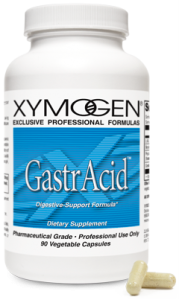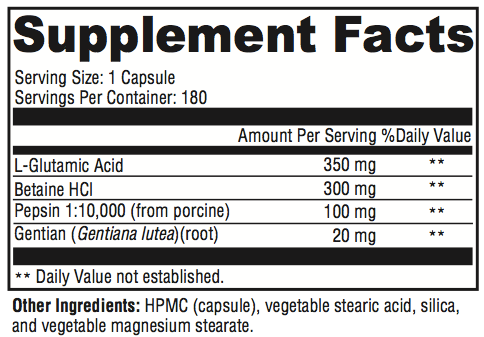GastrAcid

Glutamic Acid Hydrochloride (HCl) Also called glutamate, glutamic acid is an amino acid that can be obtained from dietary protein or synthesized endogenously from other amino acids, such as glutamine. Glutamic acid HCl is used in GasrAcid as an acidifying agent.*
Betaine Hydrochloride (HCl) Betaine (also known as trimethylglycine) is a natural substance found in foods such as beets, spinach, and grains. Research suggests that betaine supports cell health by acting as a methyl donor, and this, in turn, supports healthy methionine, homocysteine, and hepatic fat metabolism. Betaine also functions as an osmolyte, which supports the integrity of cells and proteins during fluctuations in hydration, salinity, and temperature. Betaine HCl, the acidic form of betaine, has traditionally been used to support digestion and absorption due to its ability to lower gastric pH.*[9,10]
Pepsin One of the first enzymes to initiate protein digestion, pepsin is first synthesized in the parietal cells of the gastric mucosa and secreted as the inactive zymogen precursor pepsinogen. Hydrochloric acid activates pepsinogen to convert it to pepsin once it is outside the cell. This activation sets up a chain reaction leading to the production of still more pepsin. Porcine pepsin, in addition to betaine HCl, is provided in GastrAcid with the goal of promoting more endogenous pepsin production.*[4,6]
Gentian Root (Gentiana lutea) Used for centuries to support healthy digestion, gentian contains the bitter glycosides gentiopicrin and amarogentin. Gentian’s bitter taste can be detected even at a dilution level of 50,000:1. Gentian root appears to support digestion by stimulating secretion of saliva in the mouth, hydrochloric acid in the stomach, and digestive juices from the pancreas. Due to the stimulant effect that gentian root has on endogenous production of HCl, individuals may be able to discontinue GastrAcid after a period of use.*[11-14]
GastrAcid is formulated with a variety of compounds and is designed to support gastric acidity, digestion, and normal gastrointestinal flora. GastrAcid should be taken with, or immediately following a meal. Do not use if there is a prior history of, or a current complaint of, a peptic or duodenal ulcer.*
Directions
Take 1 capsule with meals (or as directed)
References
- Bland J, Liska D, Jones DS, et al. Clinical Nutrition A Functional Approach. 2nd ed. Gig Harbor, WA: The Institute for Functional Medicine. 2004.
- Giannella RA, Broitman SA, Zamcheck N. Gastric acid barrier to ingested microorganisms in man: studies in vivo and in vitro. Gut. 1972 Apr;13(4):251-6. [PMID: 4556018]
- Lovat LB. Age related changes in gut physiology and nutritional status. Gut. 1996 Mar;38(3):306-9. [PMID: 8675079]
- Feldman M, Cryer B, McArthur KE, et al. Effects of aging and gastritis on gastric acid and pepsin secretion in humans: a prospective study. Gastroenterology. 1996 Apr;110(4):1043-52. [PMID: 8612992]
- Untersmayr E, Jensen-Jarolim E. The effect of gastric digestion on food allergy. Curr Opin Allergy Clin Immunol. 2006 Jun;6(3):214-9. Review. [PMID: 16670517]
- Smolin LA, Grosvenor MB. Nutrition: Science and Applications. 2nd ed. Hoboken, NJ: John Wiley & Sons, Inc. 2010.
- Canani RB, Terrin G. Gastric acidity inhibitors and the risk of intestinal infections. Curr Opin Gastroenterol. 2010 Jan;26(1):31-5. Review. [PMID: 19907324]
- Kanno T, Matsuki T, Oka M, et al. Gastric acid reduction leads to an alteration in lower intestinal microflora. Biochem Biophys Res Commun. 2009 Apr 17;381(4):666-70. [PMID: 19248769]
- Craig SA. Betaine in human nutrition. Am J Clin Nutr. 2004 Sep;80(3):539-49. Review. [PMID: 15321791]
- New York University Langone Medical Center. Betaine Hydrochloride. http://www.med.nyu.edu/content?ChunkIID=21560. Last Reviewed 2011. Accessed March 23, 2012.
- Mowrey D. Scientific Validation of Herbal Medicine. New Canaan, CT: McGraw-Hill. 1999.
- Monterey Bay Spice Company. Gentian Root. http://www.herbco.com/p-763-gentian-root-cs-wild-crafted.aspx. Accessed March 25, 2012.
- Vilkin A, Levi Z, Morgenstern S, et al. Higher gastric mucin secretion and lower gastric acid output in first-degree relatives of gastric cancer patients. J Clin Gastroenterol. 2008 Jan;42(1):36-41. [PMID: 18097287]
- Behrens M, Brockhoff A, Batram C, et al. The human bitter taste receptor hTAS2R50 is activated by the two natural bitter terpenoids andrographolide and amarogentin. J Agric Food Chem. 2009 Nov 11;57(21):9860-6. [PMID: 19817411]








